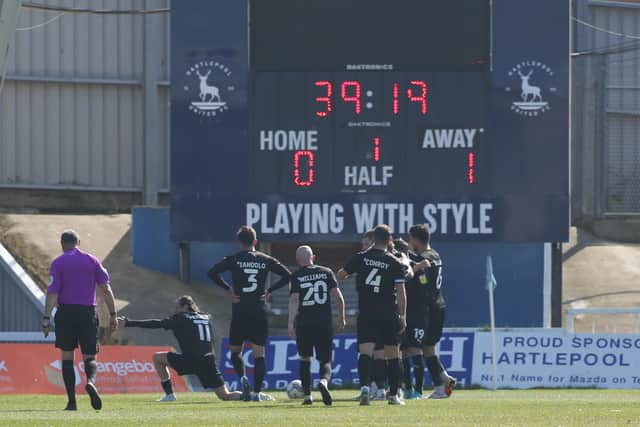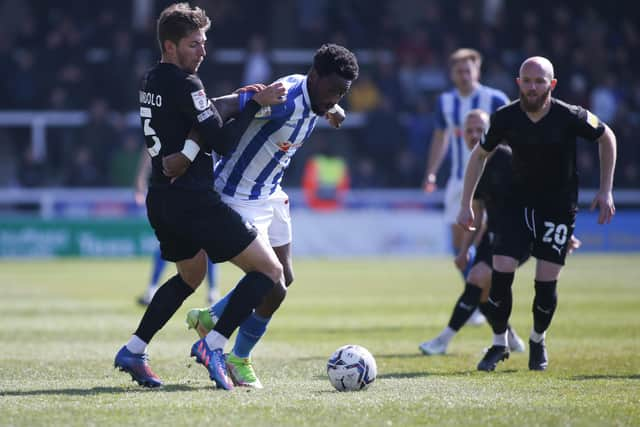Analysing the key data in Hartlepool United's defeat to Swindon Town and the numbers behind Pools' slump in form
and live on Freeview channel 276
Hartlepool United’s heavy defeat to Swindon Town has only enhanced the notion from supporters that their team have taken their foot off the pedal having secured their League Two status for another season with assistant manager Michael Nelson also declaring it is hard for him, and Graeme Lee, to defend the players after such a convincing defeat.
And with just two games of the season remaining, Pools are running out of time to prove things otherwise having taken just two points from the last 21 available to them.
Advertisement
Hide AdAdvertisement
Hide AdBut while Saturday’s defeat to Swindon was a seventh game at the Suit Direct Stadium without a win for Pools, it was perhaps the first where both Lee and Nelson will not be able to rely on the data to support their players and bat away such questions.


Standing in for Lee over the last week due to his COVID-19 diagnosis, assistant boss Nelson has suggested the players’ numerical data remains consistent with when Pools were the form team in the division back in February and early March.
But whether their running and intensity stats do mirror those from earlier in the campaign, the significant metric for supporters is the results column with Pools having won just one of their last 10 games and now facing the very realistic proposition of finishing what has, in the main, been a successful season in the lower reaches of the table.
But it is that numerical data which is worth analysing from Saturday’s lacklustre defeat which will cause further inquest.
Advertisement
Hide AdAdvertisement
Hide AdNelson oversaw his side have just 38.12 per cent of the possession as per data experts Wyscout - their lowest at the Suit Direct Stadium in the league under Lee.


Perhaps the reason behind Pools’ low possession stats is due to the decrease in the number of passes made throughout the game.
Pools completed 300 passes during the 96 minutes in total compared to Swindon’s 417 which resembles their fourth lowest tally under Lee; the others coming against league leaders Forest Green Rovers (292), League One’s Rotherham United in the semi-final of the EFL Trophy (240) and at Exeter City (286) where Pools contested a large part of the game with 10 men.
And of those passes, 51 were made to the final third which resulted in just 18 touches in the opposition box with Omar Bogle enjoying only five of those, as per Whoscored.
Advertisement
Hide AdAdvertisement
Hide AdIt’s something both Lee and Nelson have alluded to in recent weeks when asked how Pools can improve their fortunes but, clearly, it remains an issue yet to be resolved as goals continue to be hard to come by.


But the drop off in possession was not the only noticeable factor for Pools who had an expected goals (xG) of 0.86 to Swindon’s 2.83. It was the fifth game in a row Pools have failed to register an xG over 1.0 since the 2-2 draw with Mansfield Town having scored just two goals in that time, conceding nine.
And Pools were perhaps a little fortunate the Robins only scored three with Harry McKirdy going close to completing his hat-trick while Louie Barry also struck a post in the first half.
In total, Pools gave up 17 shots at Ben Killip’s goal with only Mansfield both home and away (19 and 18) and Crystal Palace in the FA Cup fourth round at Selhurst Park (20) enjoying more efforts at Pools’ goal since Lee’s appointment in December.
Advertisement
Hide AdAdvertisement
Hide AdBut to analyse why those efforts were allowed it is worth reviewing some of the defensive data from Saturday’s defeat.
Ben Garner’s side enjoyed 27 touches inside the Pools penalty area as part of their 61.18 per cent possession which, by and large, may have been attainable through Pools making just 32 interceptions throughout the game.
Lee has only seen his side make fewer interceptions on two occasions; against Colchester United (30) and during his first game in charge at the Suit Direct Stadium against Rochdale (29), each of which saw Pools come from behind to claim 2-1 wins.
Another metric worth considering, such is the nature of modern football and the much-emulated high pressing philosophy, is a team’s passing per defensive action (PPDA).
Advertisement
Hide AdAdvertisement
Hide AdThe PPDA measurement refers to how many passes a team allows their opponent to have before they commit to a defensive action such as closing down, tackling or intercepting the opposition.
This particular stat helps to establish how much a team presses higher up the field which in turn can help to force turnovers and transitions in play. The lower a team’s PPDA, the more pressing they are likely to have executed.
For Pools against Swindon, they registered a PPDA of 14.24 which means they allowed the Robins 14 passes on average before making a defensive movement to win back the ball. In contrast, Swindon had a PPDA of 5.21 which perhaps explains why they enjoyed such a significant amount of possession at the Suit Direct Stadium.
On average this season, Pools’ PPDA stands at 11.39 but in three of their last four fixtures they have surpassed that total quite considerably (14.24, 18.15 and 19.11).
Advertisement
Hide AdAdvertisement
Hide AdDoes that suggest a drop off in mentality from Pools? On its own, no. But combined with some of the other stats explained here, against Swindon at least, there is a cause for concern.
Of course, these are all stats in isolation of just one game.
But it will be interesting to see whether some of these stats improve over the final two games of the season as both Lee and Nelson seek a response from their players to regain some positivity heading into the close season.